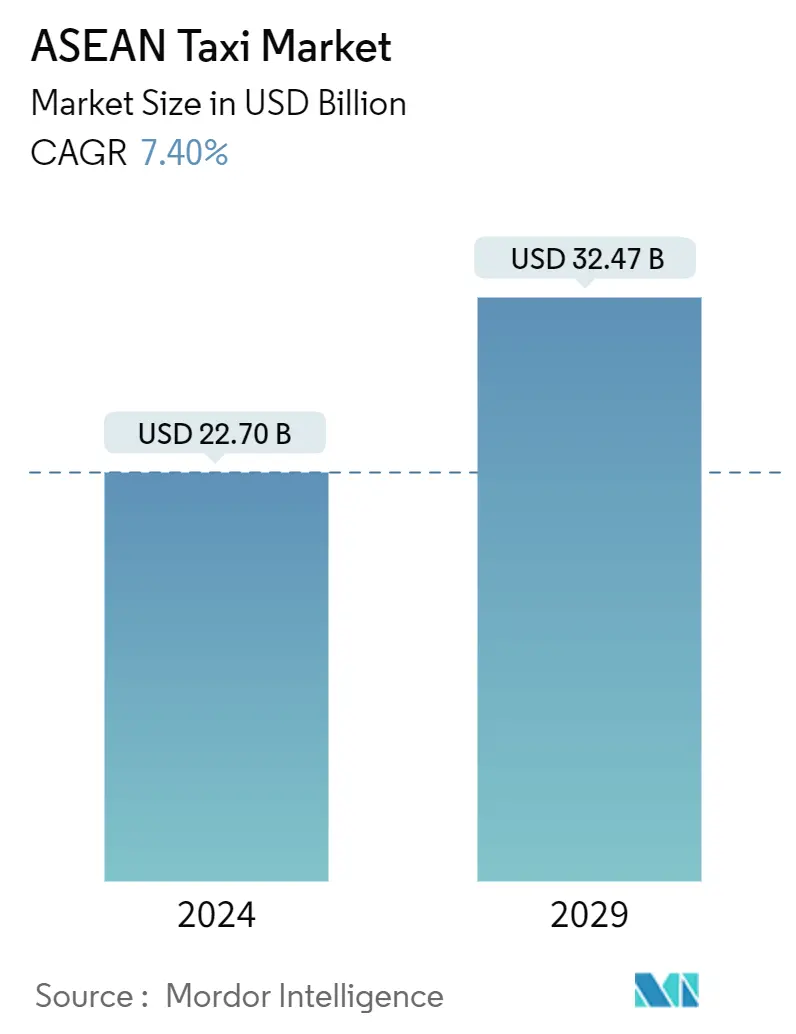Market Size of ASEAN Taxi Industry

| Study Period | 2019-2029 |
| Base Year For Estimation | 2023 |
| Market Size (2024) | USD 22.70 Billion |
| Market Size (2029) | USD 32.47 Billion |
| CAGR (2024 - 2029) | 7.40 % |
| Market Concentration | Low |
Major Players
*Disclaimer: Major Players sorted in no particular order |
ASEAN Taxi Market Analysis
The ASEAN Taxi Market size is estimated at USD 22.70 billion in 2024, and is expected to reach USD 32.47 billion by 2029, growing at a CAGR of 7.40% during the forecast period (2024-2029).
The COVID-19 pandemic hurt the market. With social distancing norms in place, the demand for shared mobility and ride-hailing services drastically reduced in the region. Furthermore, the lockdown norms implemented in this region deteriorated the demand for the taxi market by significant margins.
Consumers were unwilling to invest heavily in commodities that were only used for a short time. As a result, the taxi services industry expanded. Booking Taxis do not require maintenance and are widely available at low prices. A lack of parking spaces in congested cities and other forms of traffic congestion drives the ASEAN region's growth.
Various factors, including population rise and economic growth, make the ASEAN countries the fastest and most attractive economic market to investors. The ASEAN region includes already developed countries like Singapore, Thailand, Malaysia, and Indonesia, while developing countries with low per capita revenue, like Vietnam and The Philippines, also see a massive Taxi demand.
The rise of electric cars providing the same utility as any taxi with the added benefit of reduced ill effects on the environment is also becoming popular amongst the developing ASEAN countries. Many young engineers and entrepreneurs with experience in design and innovation see the E-Taxis industry as a massive opportunity, especially in the ASEAN markets.
ASEAN Taxi Industry Segmentation
The taxi market refers to the industry and business sector providing transportation services to passengers in hired vehicles, commonly known as taxis or cabs. Taxis are a form of public transportation where individuals or groups can hire a vehicle, typically owned and operated by a taxi company or an independent driver, to transport them to a specific destination.
The ASEAN taxi market is segmented by booking type, vehicle type, service type, and country. By booking type, the market is segmented into online and offline booking. By vehicle type, the market is segmented into motorcycles, cars, and other vehicle types, van. By service type, the market is segmented into ride-hailing and ride-sharing. By countries, the market is segmented into the Philippines, Malaysia, Thailand, Singapore, and the rest of ASEAN.
For each segment, the market sizing and forecast have been done based on value (USD).
| Booking Type | |
| Online | |
| Offline |
| Vehicle Type | |
| Motorcycles | |
| Cars | |
| Other Vehicle Types |
| Service Type | |
| Ride Hailing | |
| Ride Sharing |
| Country | |
| Philippines | |
| Malaysia | |
| Thailand | |
| Singapore | |
| Rest of ASEAN |
ASEAN Taxi Market Size Summary
The ASEAN taxi market is poised for significant growth over the forecast period, driven by a combination of factors including urbanization, economic development, and technological advancements. The market, which experienced a downturn due to the COVID-19 pandemic, is rebounding as demand for ride-hailing and ride-sharing services increases. The region's diverse economic landscape, with both developed and developing countries, presents a unique opportunity for investors. The rise of electric vehicles is also contributing to market expansion, as these environmentally friendly options gain popularity in countries like Singapore, Indonesia, and the Philippines. The integration of mobile technology in taxi services, such as app-based booking systems, is further enhancing consumer convenience and driving market growth.
The ASEAN taxi market is characterized by its fragmentation, with numerous startups and established players like Grab, Gojek, and TADA competing for market share. Strategic partnerships and joint ventures are becoming common as companies seek to leverage each other's strengths to introduce innovative services and expand their reach. Government initiatives, such as Singapore's support for electric vehicles and Indonesia's focus on increasing the electric vehicle fleet, are also playing a crucial role in shaping the market. Additionally, the introduction of new concepts like zero-commission ride-hailing services is influencing market dynamics, although they face challenges in scaling compared to more heavily funded competitors. Overall, the market is expected to continue its upward trajectory, supported by technological advancements and favorable government policies.
ASEAN Taxi Market Size - Table of Contents
-
1. MARKET DYNAMICS
-
1.1 Market Drivers
-
1.1.1 Increasing Demand From Online Channel
-
-
1.2 Market Restraints
-
1.2.1 Increasing Traffic Problems And Reliability Issues
-
-
1.3 Porter's Five Forces Analysis
-
1.3.1 Bargaining Power of Suppliers
-
1.3.2 Bargaining Power of Buyers/Consumers
-
1.3.3 Threat of New Entrants
-
1.3.4 Threat of Substitute Products
-
1.3.5 Intensity of Competitive Rivalry
-
-
-
2. MARKET SEGMENTATION (Market share in USD)
-
2.1 Booking Type
-
2.1.1 Online
-
2.1.2 Offline
-
-
2.2 Vehicle Type
-
2.2.1 Motorcycles
-
2.2.2 Cars
-
2.2.3 Other Vehicle Types
-
-
2.3 Service Type
-
2.3.1 Ride Hailing
-
2.3.2 Ride Sharing
-
-
2.4 Country
-
2.4.1 Philippines
-
2.4.2 Malaysia
-
2.4.3 Thailand
-
2.4.4 Singapore
-
2.4.5 Rest of ASEAN
-
-
ASEAN Taxi Market Size FAQs
How big is the ASEAN Taxi Market?
The ASEAN Taxi Market size is expected to reach USD 22.70 billion in 2024 and grow at a CAGR of 7.40% to reach USD 32.47 billion by 2029.
What is the current ASEAN Taxi Market size?
In 2024, the ASEAN Taxi Market size is expected to reach USD 22.70 billion.

